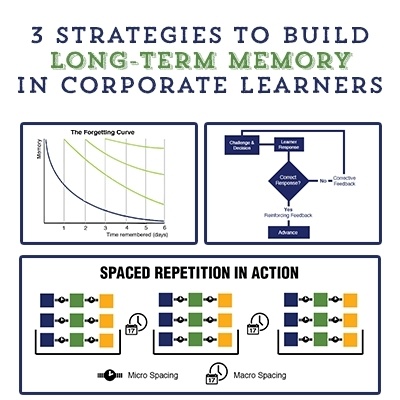"How do we design our learning solutions to maximize retention AND engagement?"
The reality is that most formal training fails to meet its business objectives. Whether the organization is looking for more sales, less support calls, fewer accidents, or other measurable goals, training can only go so far if the learning value is quickly lost.Most vendors are not much help, either. Some tout theories like Ebbinghaus’ “Forgetting Curve,” telling clients that 90% of what we learn is forgotten in a matter of days no matter what. Recent research shows us that it’s a bit more complicated than that, and while up to 90% of new information may be lost, other factors like prior knowledge and attitude play a big part.So while the fact remains that most learning is forgotten when training is a one-time event, we need to avoid over-generalizations and focus on ways to improve measurable outcomes… despite the brain’s troubling capacity to forget.
3 Research-Validated Strategies for Helping Corporate Learners Acquiring New Knowledge
With that in mind, here are three research-validated strategies for helping corporate learners acquire new knowledge… and retain it for the long term.
- Space Out the Learning
Break content up into smaller chunks within a single learning event, then provide additional spacing by exposing corporate learners to the same materials days or even weeks later.This is called “micro-spacing” and “macro spacing”. - Repeat, Repeat, Repeat
Show corporate learners the same content in a slightly different format. If you present a True/False question the first time, show corporate learners a scenario-based question the second time and an application question the third time. Presenting the same information in a different context is proven to aid in retention. - Provide Meaningful Feedback
Don’t let corporate learners complete their session until they have had a chance to succeed. If I complete an activity incorrectly and advance, that incorrect completion is embedded in my memory and I will be more likely to fail in the future. A simple Post-test is not sufficient to anchor memories, as it does not require a correct answer for every question to advance.It is also important to provide positive feedback upon successful completion of an activity. In a game or gamified course, this can come in the form of points, badges, or other achievements.
Build these techniques into your learning designs
When the goal of training is just to communicate or drive awareness, research-based learning methods have less value. However, when the goal is for corporate learners to gain new knowledge and skills that they must know cold, techniques such as spaced repetition and feedback loops are central to learning design.The techniques described above are referred to as spaced learning, repetition and feedback loops. For more information on these techniques, the research behind them, and a case study of successful application, refer to this guide: A Primer on Spaced Repetition and Feedback Loops.







